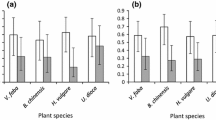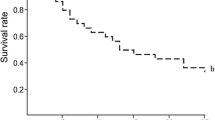Abstract
Effects of the number of larvae per Petri dish (1, 5, and 10) on the preimaginal development of individuals of the native (Irkutsk, southern Siberia) and invasive (Sochi, the Northern Caucasus) populations of the multicolored Asian ladybird Harmonia axyridis were investigated in the laboratory. The experiments were conducted under short (12 h) and long (18 h) day conditions; the larvae were fed on the green peach aphid Myzus persicae or on the eggs of the grain moth Sitotroga cerealella. An increase in the number of larvae developed in one Petri dish resulted in a significant decrease in the rate of development in individuals from both populations which fed on aphids. Survival decreased with an increase in the number of larvae developed in one Petri dish fed on both prey species, but only in larvae from the invasive population of H. axyridis. The weight of emerging adults decreased with the number of larvae per dish in individuals from both study populations, but only when fed on aphids. These data suggest that the influence of density-dependent factors on the development of H. axyridis depends significantly on larval prey species. In addition, larvae from the invasive population have somewhat more aggressive interactions with competitors, this possibly having been one of the prerequisites for invasion.
Similar content being viewed by others
References
Alhmedi, A., Haubruge, E., and Francis, F., “Intraguild Interactions and Aphid Predators: Biological Efficiency of Harmonia axyridis and Episyrphus balteatus,” Journal of Applied Entomology 134 (1), 34–44 (2010).
Bayoumy, M.H. and Michaud, J.P., “Cannibalism in Two Subtropical Lady Beetles (Coleoptera: Coccinellidae) as a Function of Density, Life Stage, and Food Supply,” Journal of Insect Behavior 28 (4), 387–402 (2015).
Belyakova, N.A. and Reznik, S.Ya., “First Record of the Harlequin Ladybird, Harmonia axyridis (Coleoptera: Coccinellidae) in the Caucasus,” European Journal of Entomology 110 (4), 699–702 (2013).
Berkvens, N., Bonte, J., Berkvens, D., Tirry, L., and De Clercq, P., “Influence of Diet and Photoperiod on Development and Reproduction of European populations of Harmonia axyridis (Pallas) (Coleoptera: Coccinellidae),” BioControl 53 (1), 211–221 (2008).
Brown, P.M.J., Thomas, C.E., Lombaert, E., Jeffries, D.L., Estoup, A., Handley, L.J.L., “The Global Spread of Harmonia axyridis (Coleoptera: Coccinellidae): Distribution, Dispersal and Routes of Invasion,” BioControl. 56 (4), 623–641 (2011).
Burgio, G., Santi, F., and Maini, S., “On Intra-Guild Predation and Cannibalism in Harmonia axyridis (Pallas) and Adalia bipunctata L. (Coleoptera: Coccinellidae),” Biological Control 24 (2), 110–116 (2002).
Dgebuadze, Yu.Yu., “Alien Species in Holarctic: Some Results and Perspective of Investigations,” Rossiiskii Zhurnal Biologicheskikh Invazii 1, 2–8 (2014).
Felix, S. and Soares, A.O., “Intraguild Predation between the Aphidophagous Ladybird Beetles Harmonia axyridis and Coccinella undecimpunctata (Coleoptera: Coccinellidae): the Role of Body Weight,” European Journal of Entomology 101 (2), 237–242 (2004).
Gagnon, A.È. and Brodeur, J., “Impact of Plant Architecture and Extraguild Prey Density on Intraguild Predation in an Agroecosystem,” Entomologia Experimentalis et Applicata 152 (2), 165–173 (2014).
Gagnon, A.È., Heimpel, G.E., and Brodeur, J., “The Ubiquity of Intraguild Predation among Predatory Arthropods,” PLoS One 6 (11), e28061 (2011).
Hodek, I. and Evans, E.W., “Food Relationships,” in Ecology and Behaviour of the Ladybird Beetles (Blackwell Publishing, Chichester, UK, 2012), pp 141–274.
Izhevsky, S.S., “Invasion of Alien Pests in European Russia Continues,” Zashchita i Karantin Rastenii 6, 25–28 (2008).
Kajita, Y., Takano, F., Yasuda, H., and Agarwala, B.K., “Effects of Indigenous Ladybird Species (Coleoptera: Coccinellidae) on the Survival of an Exotic Species in Relation to Prey Abundance,” Applied Entomology and Zoology 35 (4), 473–479 (2000).
Katsanis, A., Babendreier, D., Nentwig, W., and Kenis, M., “Intraguild Predation between the Invasive Ladybird Harmonia axyridis and Non-Target European Coccinellid Species,” BioControl 58(1), 73–83 (2013).
Kumar, B., Mishra, G., and Omkar, “Functional Response and Predatory Interactions in Conspecific and Heterospecific Combinations of two Congeneric Species (Coleoptera: Coccinellidae),” European Journal of Entomology 111 (2), 257–265 (2014a).
Kumar, B., Mishra, G., and Omkar, “Larval and Female Footprints as Feeding Deterrent Cues for Immature Stages of Two Congeneric Ladybird Predators (Coleoptera: Coccinellidae),” Bulletin of Entomological Research 104 (5), 652–660 (2014b).
Lucas, E., “Intraguild Predation among Aphidophagous Predators,” European Journal of Entomology 102 (3), 351–364 (2005).
Meisner, M.H., Harmon, J.P., and Ives, A.R., “Response of Coccinellid Larvae to Conspecific and Heterospecific Larval Tracks: a Mechanism that Reduces Cannibalism and Intraguild predation,” Environmental Entomology 40 (1), 103–110 (2011).
Michaud, J.P., “A Comparative Study of Larval Cannibalism in Three Species of Ladybird,” Ecological Entomology 28 (1), 92–101 (2003).
Michaud, J.P. and Grant, A.K., “Adaptive Significance of Sibling Egg Cannibalism in Coccinellidae: Comparative Evidence from Three Species,” Annals of the Entomological Society of America 97 (4), 710–719 (2004).
Orlova-Bienkowskaja, M.J., “Propagation of Invasive Harlequin Ladybird Harmonia axyridis (Pallas, 1773) (Coleoptera, Coccinellidae) in the Caucasus and Possible Sources of Invasion,” Rossiiskii Zhurnal Biologicheskikh Invazii 3, 73–82 (2014).
Orlova-Bienkowskaja, M.J., Ukrainsky, A.S., and Brown, P.M., “Harmonia axyridis (Coleoptera: Coccinellidae) in Asia: a Re-examination of the Native Range and Invasion to Southeastern Kazakhstan and Kyrgyzstan,” Biological Invasions 17 (7), 1941–1948 (2015).
Osawa, N., “Sibling Cannibalism in the Ladybird Beetle Harmonia axyridis: Fitness Consequences for Mother and Offspring,” Researches on Population Ecology 34 (1), 45–55 (1992).
Osawa, N., “Ecology of Harmonia axyridis in Natural Habitats within its Native Range,” BioControl 56 (4), 613–621 (2011).
Pervez, A., Gupta, A.K., and Omkar, “Larval Cannibalism in Aphidophagous Ladybirds: Influencing Factors, Benefits and Costs,” Biological Control 38 (3), 307–313 (2006).
Raak-van den Berg, C.L., De Lange, H.J., and Van Lenteren, J.C., “Intraguild Predation Behaviour of Ladybirds in Semi-Field Experiments Explains Invasion Success of Harmonia axyridis,” PloS one 7 (7), e40681 (2012).
Reznik, S.Ya., Ovchinnikov, A.N., Dolgovskaya, M.Yu., and Belyakova, N.A., “Interspecific Variation in Photoperiodic Effect on the Rate of Preimaginal Development in Harmonia axyridis (Pallas) (Coleoptera, Coccinellidae),” Entomologicheskoe Obozrenie 94 (1), 35–52 (2015a) [Entomological Review 95 (1), 15–27 (2015a)].
Reznik, S.Ya., Dolgovskaya, M.Yu., Ovchinnikov, A.N., and Belyakova, N.A., “Weak Photoperiodic Response Facilitates the Biological Invasion of the Harlequin Ladybird Harmonia axyridis (Pallas) (Coleoptera: Coccinellidae),” Journal of Applied Entomology 139 (4), 241–249 (2015b).
Roy, H.E., Brown, P.M., Adriaens, T. et al., “The Harlequin Ladybird, Harmonia axyridis: Global Perspectives on Invasion History and Ecology,” Biological Invasions 18 (4), 997–1044 (2016).
Sato, S., Jimbo, R., Yasuda, H., and Dixon, A.F.G., “Cost of Being an Intraguild Predator in Predatory Ladybirds,” Applied Entomology and Zoology 43 (1), 143–147 (2008).
Sloggett, J.J., “Harmonia axyridis Ivasions: Deducing Evolutionary Causes and Consequences,” Entomological Science 15 (3), 261–273 (2012).
Soares, A.O. and Serpa, A., “Interference Competition between Ladybird Beetle Adults (Coleoptera: Coccinellidae): Effects on Growth and Reproductive Capacity,” Population Ecology 49 (1), 37–43 (2007).
Tayeh, A., Estoup, A., Lombaert, E. et al., “Cannibalism in Invasive, Native and Biocontrol Populations of the Harlequin Ladybird,” BMC Evolutionary Biology 14 (15), 1–9 (2014).
Turnipseed, R.K., Ugine, T.A., and Losey, J.E., “Effect of Prey Limitation on Competitive Interactions between a Native Lady Beetle, Coccinella novemnotata, and an Invasive Lady Beetle, Coccinella septempunctata (Coleoptera: Coccinellidae),” Environmental Entomology 43 (4), 969–976 (2014).
Ukrainsky, A.S. and Orlova-Bienkowskaja, M.J., “Expansion of Harmonia axyridis Pallas (Coleoptera: Coccinellidae) to European Russia and Adjacent Regions,” Biological Invasions 16 (5), 1003–1008 (2014).
Ungerová, D., Kalushkov, P. and Nedved, O., “Suitability of Diverse Prey Species for Development of Harmonia axyridis and the Effect of Container Size,” IOBC/WPRS Bulletin 58, 165–174 (2010).
Wagner, J.D., Glover, M.D., Moseley, J.B., and Moore, A.J., “Heritability and Fitness Consequences of Cannibalism in Harmonia axyridis,” Evolutionary Ecology Research 1 (3), 375–388 (1999).
Ware, R., Yguel, B., and Majerus, M., “Effects of Competition, Cannibalism and Intraguild Predation on Larval Development of the European coccinellid Adalia bipunctata and the Invasive Species Harmonia axyridis,” Ecological Entomology 34 (1), 12–19 (2009).
Williamson, M., “Explaining and Predicting the Success of Invading Species at Different Stages of Invasion,” Biological Invasions 8 (7), 1561–1568 (2006).
Author information
Authors and Affiliations
Corresponding author
Additional information
Original Russian Text © S.Ya. Reznik, N.A. Belyakova, A.N. Ovchinnikov, A.A. Ovchinnikova, 2017, published in Zoologicheskii Zhurnal, 2017, Vol. 96, No. 9, pp. 1048–1053.
Rights and permissions
About this article
Cite this article
Reznik, S.Y., Belyakova, N.A., Ovchinnikov, A.N. et al. The influence of density-dependent factors on larval development in native and invasive populations of Harmonia axyridis (Pall.) (Coleoptera, Coccinellidae). Entmol. Rev. 97, 847–852 (2017). https://doi.org/10.1134/S0013873817070016
Received:
Published:
Issue Date:
DOI: https://doi.org/10.1134/S0013873817070016




